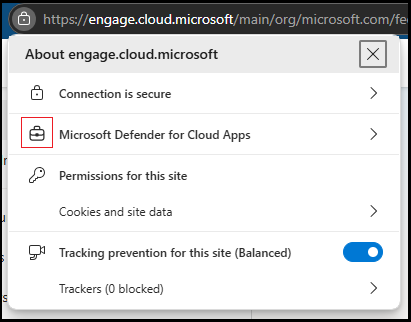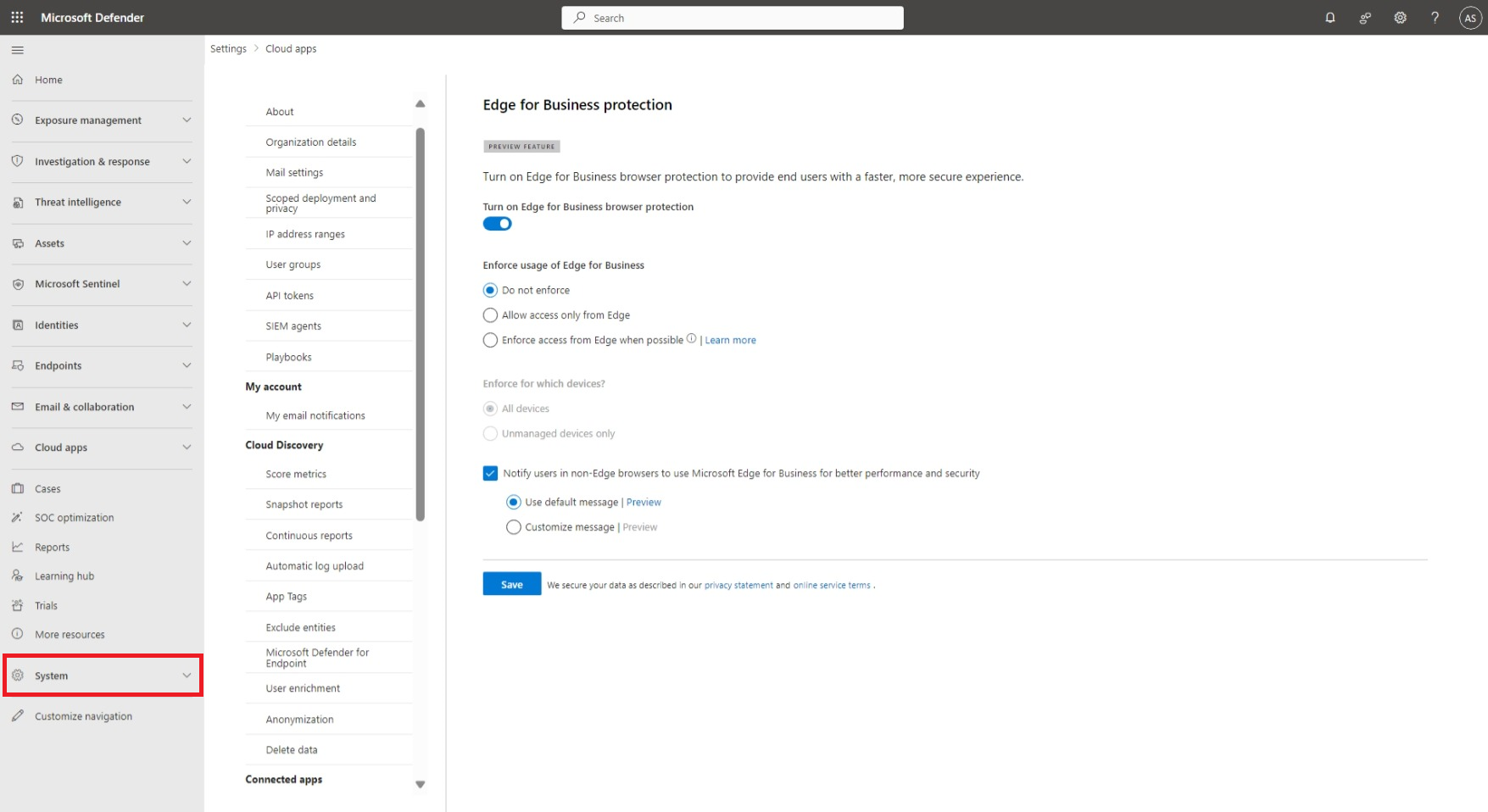In-browser protection with Microsoft Edge for Business (Preview)
Defender for Cloud Apps users who use Microsoft Edge for Business and are subject to session policies are protected directly from within the browser. In-browser protection reduces the need for proxies, improving both security and productivity.
Protected users experience a smooth experience with their cloud apps, without latency or app compatibility issues, and with a higher level of security protection.
In-browser protection requirements
To use in-browser protection, users must be in their browser's work profile.
Microsoft Edge profiles allow users to split browsing data into separate profiles, where the data that belongs to each profile is kept separate from the other profiles. For example, when users have different profiles for personal browsing and work, their personal favorites and history aren't synchronized with their work profile.
When users have separate profiles, their work browser (Microsoft Edge for Business) and personal browser (Microsoft Edge) have separate caches and storage locations, and information remains separate.
To use in-browser protection, users must also have the following environmental requirements in place:
| Requirement | Description |
|---|---|
| Operating systems | Windows 10 or 11, macOS |
| Identity platform | Microsoft Entra ID |
| Microsoft Edge for Business versions | The last two stable versions. For example, if the newest Microsoft Edge is 126, in-browser protection works for v126 and v125. For more information, see Microsoft Edge releases. |
| Supported session policies |
Users that are served by multiple policies, including at least one policy that's not supported by Microsoft Edge for Business, their sessions are always served by the reverse proxy. Policies defined in the Microsoft Entra ID portal are also always served by reverse proxy. |
All other scenarios are served automatically with the standard reverse proxy technology, including user sessions from browsers that don't support in-browser protection, or for policies not supported by in-browser protection.
For instance, these scenarios are served by the reverse proxy:
- Google Chrome users.
- Microsoft Edge users who are scoped to a protect file download policy.
- Microsoft Edge users on Android devices.
- Users in apps that use the OKTA authentication method.
- Microsoft Edge users in InPrivate mode.
- Microsoft Edge users with older browser versions.
- B2B guest users.
- Session is scoped to a Conditional Access policy defined in Microsoft Entra ID portal.
User experience with in-browser protection
To confirm that in-browser protection is active, users need to select the "lock" icon in the browser's address bar and look for the "suitcase" symbol in the form that appears. The symbol indicates that the session is protected by Defender for Cloud Apps. For example:

Also, the .mcas.ms suffix doesn't appear in the browser address bar with in-browser protection, as it does with standard Conditional Access app control, and developer tools are turned off with in-browser protection.
Work profile enforcement for in-browser protection
To access a work resource in contoso.com with in-browser protection, users must sign in with their username@contoso.com profile. If users try to access the work resource from outside the work profile, they're prompted to switch to the work profile or create one if it doesn't exist. Users can also choose to continue with their current profile, in which case they're served by the reverse proxy architecture.
If the user decides to create a new work profile, they're prompted with the Allow my organization to manage my device option. In such cases, users don't need to select this option to create the work profile or benefit from in-browser protection.
For more information, see Microsoft Edge for Business and How to add new profiles to Microsoft Edge.
Configure in-browser protection settings
In-browser protection with Microsoft Edge for Business is turned on by default. Admins can turn the integration off and on, and can configure a prompt for non-Microsoft Edge users to switch to Microsoft Edge for enhanced performance and security.
In the Microsoft Defender portal at https://security.microsoft.com, go to System > Settings > Cloud apps > Conditional Access App Control section > Edge for Business protection. Or, to go directly to the Edge for Business protection page, use https://security.microsoft.com/cloudapps/settings?tabid=edgeIntegration.
On the Edge for Business protection page, configure the following settings as needed:
Turn on Edge for Business browser protection: The default value is On, but you can toggle the setting to Off.
Notify users in non-Edge browsers to use Microsoft Edge for Business for better performance and security: If you select the check box, select one of the following values that appear:
- Use default message (default)
- Customize message: Enter the custom text in the box that appears.
Use the Preview link to see the notification.
When you're finished on the Edge for Business protection page, select Save.
Working with Microsoft Purview and Endpoint data loss prevention
If the same exact context and action are configured for both Defender for Cloud Apps policies and a Microsoft Purview Endpoint data loss prevention policy (DLP), the Endpoint DLP policy is applied.
For example, you have an Endpoint DLP policy that blocks a file upload to Salesforce, and you also have a Defender for Cloud Apps policy that monitors file uploads to Salesforce. In this scenario, the Endpoint DLP policy is applied.
For more information, see Learn about data loss prevention.
Enforce Microsoft Edge browser protection when accessing business apps
Administrators who understand the power of Microsoft Edge browser protection can require users to use Microsoft Edge when accessing corporate resources. A primary reason is security, since the barrier to circumventing session controls using Microsoft Edge is much higher than with reverse proxy technology.
In the Microsoft Defender portal at https://security.microsoft.com, go to System > Settings > Cloud apps > Conditional Access App Control section > Edge for Business protection. Or, to go directly to the Edge for Business protection page, use https://security.microsoft.com/cloudapps/settings?tabid=edgeIntegration.
On the Edge for Business protection page, as long as Turn on Edge for Business browser protection is on, Enforce usage of Edge for Business is available with the following values:
Do not enforce (default)
Allow access only from Edge: Access to the business application (scoped to session policies) is available only via the Microsoft Edge browser.
Enforce access from Edge when possible: Users should use Microsoft Edge to access the application if their context permits. Otherwise, they might use a different browser to access the protected application.
For example, a user is subject to a policy that doesn't align with in-browser protection capabilities (for example, Protect file upon download) OR the operating system is incompatible (for instance, Android).
In this scenario, because the user lacks control over the context, they might opt to use a different browser.
If the applicable policies allow it and the operating system is compatible (Windows 10, 11, macOS), the user is required to use Microsoft Edge.
If you select Allow access only from Microsoft Edge or Enforce access from Microsoft Edge when possible, the Enforce for which devices? setting is available with the following values:
- All devices (default)
- Unmanaged devices only
When you're finished on the Edge for Business protection page, select Save.
Related content
For more information, see Microsoft Defender for Cloud Apps Conditional Access app control.
